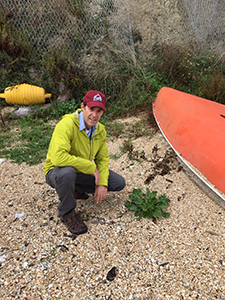Drawing a Map to Hidden Genetic Treasure

Chris Richards crouching by a sea beet (a wild relative species of sugar beet) near Ancona, Italy. (Photo by Piergiorgio Stevanato, Universita Di Padova)
In a profound sense, seeds are a kind of treasure – one that, when buried, produces life. But finding a map for that treasure turns out to be a tricky task. To help tackle it, scientists working within the USDA’s National Plant Germplasm System have begun to build an updated, modern GPS to reliably guide breeders and others to the information they need.
When the collection was first assembled over 100 years ago, the accessions — samples of seeds from plants collected around the world — were catalogued using the methods of the time: curators described plants’ physical, visible (phenotypic) characteristics — things like height and leaf shape. A lot has changed since then; notably, users of the collection are now likely to be interested in the genetic basis of traits useful for agriculture, which might not be visible as a phenotype. Today a search is likely to begin with a query of the collection’s online database, GRIN, which tracks the information and inventories of over 600,000 physical samples.
“What we’re trying to do is provide genetic information that reflects the diversity of the population as opposed to a single individual,” said Patrick Reeves, a geneticist at the Agricultural Genetic Resources Preservation Research Unit (AGRPRU) in Fort Collins, CO. “The way that we do that is that, rather than sequencing 100 individuals from the population and then combining that data, we just whole genome sequence the 100 pooled individuals at one time, and then use computational methods to sort out the sequence diversity in that sample so the user could look at that data and say, ‘I have a 75% chance of getting this allele [a particular genetic variation] when I grow out the accession.’” The combined catalog of variation in the sample is referred to as a “pan-genome.”
The process requires, according to Reeves, about a week to get the DNA, a month to have it sequenced to generate raw data, and then another 2 weeks to complete computational work that encapsulates information about the variation within a given population sample.
The result offers users a much richer trove of data than previous methods.
“With a pooled sequencing approach, a user can make a very efficient and focused germplasm request,” said Chris Richards, a plant geneticist at AGRPRU. “Querying the pan-genome structure of these accessions, the user could say ‘ok, here’s a region of the genome I’m particularly interested in, give me an accession that has the most variation in that region.’ That’s really powerful.”

Little barley alongside wheat growing in St Louis, MO. (Photo courtesy of Natalie G. Mueller)
As the new technology is expanded, researchers believe it may unlock yet more possibilities within the collection. One of the most intriguing is the ability to do so-called “genomic prediction” – using data from genomes to extrapolate a picture of what a mature plant might offer, without even growing the seed.
To date, the researchers have sequenced a handful of species from the collection, including wild relatives of sugar beet and a North American wild relative of barley called ‘little barley’ – the former out-crossing and heterogenous, the latter uniform and self-pollinating. Now, the only limit is the human resources needed to move the project forward.
Comparing the process to gold mining, Reeves said, “All the data and the materials we’re working with right now is just organizing the paydirt, but we need a lot more bioinformaticians and more data to get the ore out.”
Doing so could be critical to developing new crop varieties, as a growing population and hotter, more erratic weather patterns make it more challenging to feed the global population.
“Many models suggest that global food production should increase by 50% in the next 25-30 years,” said Richards. “If we start crossing the best of the best within, say, corn, or wheat, or rice, we’re only going to get partially there, because we’re just re-arranging the parts that have been useful in the past. The alternative way to increase yield is to go back to the crop wild relative gene pool or some foundational landrace [a locally-adapted material] that predates modern hybrid development and start looking for variation that’s novel.”
Doing so, he said, would increase the range of available flavors and textures and colors in the marketplace, but it will also support food sustainability.
“We have to make use of every available tactic,” Richards said. — by Kathryn Markham, ARS Office of Communications
You May Also Like

